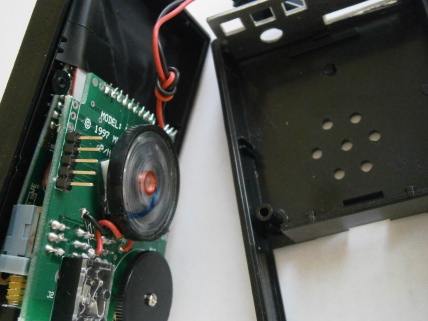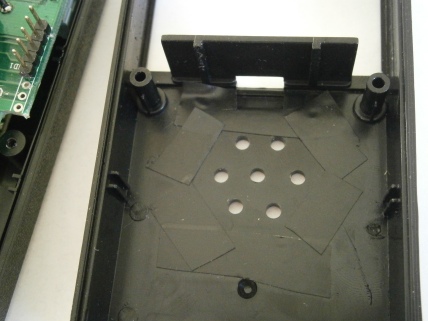MFJ-418 Pocket Morse Code Tutor -
Distortion Fix
It's not hard to find people who
(mostly) love the MFJ-418 Pocket Morse Code Tutor. But there is a
common complaint of low volume and high distortion when using the
internal speaker. A lot of people say they stick to headphones while
using it for that reason. Turns out there's an easy fix.
Disclaimer
I have no affiliation
with MFJ, other than owning a few of their products. Assorted comments
below are based on my own observations and
assumptions, any of which could be wrong.
Use of the information on these pages is AT YOUR OWN RISK. I'm
reporting what worked for me, I hope it will help you. If you elect to
try the same, and if in the process you blow up your MFJ product, PC,
refrigerator, and/or cat box; I can't help you with that. You are on
your own.
This project does not require soldering skills unless you break
something.
The Problem

I've purchased two of these units, about 12 years apart
and they both
suffered the same symptom. New out of the box, if you
advanced the volume control past a very low level, the sound coming out
of the speaker was severely distorted. Advancing the volume control
only served to increase the distortion, for little increase in volume
level. However, sound out of the headphone jack was clean at all
levels. Your unit might not have this problem; some of the folks on
eham.net say theirs works fine. But if yours has this problem, you'll
know it.
On my units, if I flexed the case while the unit was operating, the
distortion would change. This was a good clue that it was a mechanical
problem. The cause boils down to the little speaker cone smacking into
the plastic case. There is not enough clearance between the surface of
the cone (it's more of a disk, actually) and the plastic case it is
pressed directly against.
The Easy Fix
 You have a choice of either
scraping out some of the
case plastic (probably near the center of the speaker where the disk
bulges out), or putting some spacing under the speaker. If I had a
milling machine, I would have probably scraped out some of the case.
I'd guess it could also be done satisfactorily by hand, but it seemed
easier and safer to go the spacing route.
You have a choice of either
scraping out some of the
case plastic (probably near the center of the speaker where the disk
bulges out), or putting some spacing under the speaker. If I had a
milling machine, I would have probably scraped out some of the case.
I'd guess it could also be done satisfactorily by hand, but it seemed
easier and safer to go the spacing route.
What I did was simply to add a crude circle of electrical tape. Ideally
this would only contact the black rim of the speaker, but in practice
it doesn't seem to be that critical. I just eyeballed it and it works
great. I get MUCH more volume out of the thing, and little distortion
(as far as I can tell). I used regular black electrical tape, cut to
half-width strips. It only needed one layer (there is overlap in spots
as you can see). Probably anything you care to use to space the speaker
frame out a tiny bit will do the trick.
As the units seem to vary, yours might need more spacing/layers. The
only way to find out is to try it and see what happens.
Don't forget to remove the battery before disassembling. Remove the two
screws from the back and the thing comes apart easily. Be careful not
to break the battery wires, and route them so they do not get pinched
when the case goes back together.

Larry
AD6G


 You have a choice of either
scraping out some of the
case plastic (probably near the center of the speaker where the disk
bulges out), or putting some spacing under the speaker. If I had a
milling machine, I would have probably scraped out some of the case.
I'd guess it could also be done satisfactorily by hand, but it seemed
easier and safer to go the spacing route.
You have a choice of either
scraping out some of the
case plastic (probably near the center of the speaker where the disk
bulges out), or putting some spacing under the speaker. If I had a
milling machine, I would have probably scraped out some of the case.
I'd guess it could also be done satisfactorily by hand, but it seemed
easier and safer to go the spacing route.